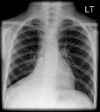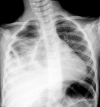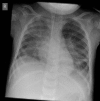Pneumonia in the immunocompetent patient
- PMID: 21088086
- PMCID: PMC3473604
- DOI: 10.1259/bjr/31200593
Pneumonia in the immunocompetent patient
Abstract
Pneumonia is an acute inflammation of the lower respiratory tract. Lower respiratory tract infection is a major cause of mortality worldwide. Pneumonia is most common at the extremes of life. Predisposing factors in children include an under-developed immune system together with other factors, such as malnutrition and over-crowding. In adults, tobacco smoking is the single most important preventable risk factor. The commonest infecting organisms in children are respiratory viruses and Streptoccocus pneumoniae. In adults, pneumonia can be broadly classified, on the basis of chest radiographic appearance, into lobar pneumonia, bronchopneumonia and pneumonia producing an interstitial pattern. Lobar pneumonia is most commonly associated with community acquired pneumonia, bronchopneumonia with hospital acquired infection and an interstitial pattern with the so called atypical pneumonias, which can be caused by viruses or organisms such as Mycoplasma pneumoniae. Most cases of pneumonia can be managed with chest radiographs as the only form of imaging, but CT can detect pneumonia not visible on the chest radiograph and may be of value, particularly in the hospital setting. Complications of pneumonia include pleural effusion, empyema and lung abscess. The chest radiograph may initially indicate an effusion but ultrasound is more sensitive, allows characterisation in some cases and can guide catheter placement for drainage. CT can also be used to characterise and estimate the extent of pleural disease. Most lung abscesses respond to medical therapy, with surgery and image guided catheter drainage serving as options for those cases who do not respond.
Figures














Similar articles
-
Imaging pneumonia in immunocompetent and immunocompromised individuals.Curr Opin Pulm Med. 2012 May;18(3):194-201. doi: 10.1097/MCP.0b013e328351f953. Curr Opin Pulm Med. 2012. PMID: 22388581 Review.
-
Reliability of radiographic findings and the relation to etiologic agents in community-acquired pneumonia.Respir Med. 2006 May;100(5):926-32. doi: 10.1016/j.rmed.2005.06.018. Epub 2005 Dec 6. Respir Med. 2006. PMID: 16337367
-
Pneumonia. Pearls for interpreting patients' radiographs.Postgrad Med. 1991 Oct;90(5):58-66, 69-73. doi: 10.1080/00325481.1991.11701071. Postgrad Med. 1991. PMID: 1924016
-
Imaging of Community-acquired Pneumonia.J Thorac Imaging. 2018 Sep;33(5):282-294. doi: 10.1097/RTI.0000000000000347. J Thorac Imaging. 2018. PMID: 30036297 Review.
-
Relationships between Th1/Th2 cytokine profiles and chest radiographic manifestations in childhood Mycoplasma pneumoniae pneumonia.Ther Clin Risk Manag. 2016 Nov 11;12:1683-1692. doi: 10.2147/TCRM.S121928. eCollection 2016. Ther Clin Risk Manag. 2016. PMID: 27956836 Free PMC article.
Cited by
-
Correlation between chest radiographic findings and clinical features in hospitalized children with Mycoplasma pneumoniae pneumonia.PLoS One. 2019 Aug 28;14(8):e0219463. doi: 10.1371/journal.pone.0219463. eCollection 2019. PLoS One. 2019. PMID: 31461462 Free PMC article.
-
Anti-inflammatory Effect of Symplocos prunifolia Extract in an In Vitro Model of Acute Pneumonia.Plant Foods Hum Nutr. 2024 Dec;79(4):893-900. doi: 10.1007/s11130-024-01231-5. Epub 2024 Sep 10. Plant Foods Hum Nutr. 2024. PMID: 39254770
-
Exploring Bioactive Phytomedicines for Advancing Pulmonary Infection Management: Insights and Future Prospects.Phytother Res. 2024 Dec;38(12):5840-5872. doi: 10.1002/ptr.8334. Epub 2024 Oct 9. Phytother Res. 2024. PMID: 39385504 Free PMC article. Review.
-
Synergistic Action of Antimicrobial Lung Proteins against Klebsiella pneumoniae.Int J Mol Sci. 2021 Oct 15;22(20):11146. doi: 10.3390/ijms222011146. Int J Mol Sci. 2021. PMID: 34681806 Free PMC article.
-
COVID-19 Pandemic and Upcoming Influenza Season-Does an Expert's Computed Tomography Assessment Differentially Identify COVID-19, Influenza and Pneumonias of Other Origin?J Clin Med. 2020 Dec 28;10(1):84. doi: 10.3390/jcm10010084. J Clin Med. 2020. PMID: 33379386 Free PMC article.
References
-
- World Health Organization The global burden of disease: 2004 update. WHO Press, 2008
-
- Hirschtick R, Glossroth J, Jordan M, Wilcosky T, Wallace J, Kvale T. Bacterial pneumonia in persons infected with the human immunodeficiency virus. Pulmonary Complications of HIV Infection Study Group. N Engl J Med 1995;333:845–51 - PubMed
-
- Shariatzadeh M, Huang J, Tyrrell G, Johnson M, Marrie T. Bacteremic pneumococcal pneumonia: a prospective study in Edmonton and neighbouring municipalities. Medicine (Baltimore) 2005;84:147–61 - PubMed
-
- Tuomanen E, Austrian R, Masure HR. Pathogenesis of pneumococcal infection. N Engl J Med 2009;332:1280–4 - PubMed
Publication types
MeSH terms
LinkOut - more resources
Full Text Sources
Medical

